Dampfnudel (German Steamed Dumplings)
This post may contain affiliate links. See my disclosure policy.
Fluffy steamed yeast dumplings drizzled with homemade vanilla sauce – that’s the very definition of comfort food! This authentic Dampfnudel recipe is from my home of Southern Germany and is made the way my Mutti and Oma made them. A childhood favorite (and still is), I have many treasured memories of sitting down to a freshly made Dampfnudel drenched with a generous serving of Mutti’s Vanillesoße. It’s so filling it’s usually served as a main meal. Dessert for dinner you ask? Aber natürlich!
Serve these Dampfnudeln with our homemade German Vanilla Sauce! And for the popular Austrian version of these dumplings, try our Germknödel!
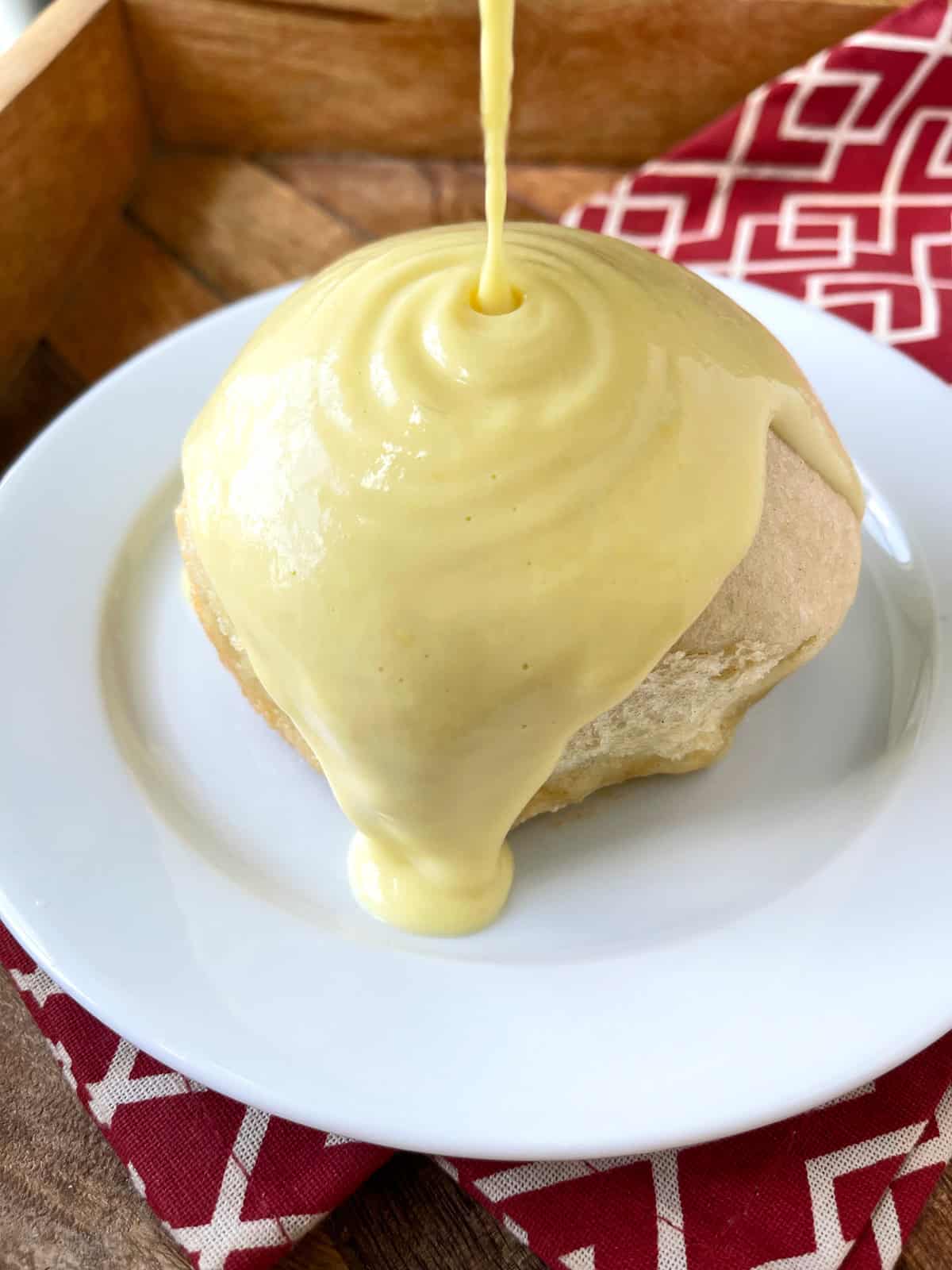
Dampfnudeln are synonymous with my childhood, a staple of my German upbringing. And even through my young adulthood my Mutti would make these for us and we’d gather around our table in southern Germany to enjoy this exquisite indulgence and catch up on family news. There’s nothing like family time and laughter shared around sweet yeasted dumplings drizzled with browned butter and drenched in homemade vanilla sauce. And when I say drenched, Mutti always knew me well enough to make a double portion. For as long as I can remember, she used a black high-rimmed lidded pan that was well-seasoned from years and years of use, a pan she got from my Oma, and this was also the pan she would use for things like Senfbraten, Sauerbraten, Rouladen. She still has that pan and has promised that one day it will be mine.
What is a Dampfnudel?
Dampfnudeln, or steamed yeast dumplings, is a very traditional German dish. The German word Dampfnudel (singular) translates as “steam noodle.” Noodle seems like an odd name for this dish but the word “nudel” as it was used historically actually referred specifically to Knödel, or dumplings. The method of making Dampfnudeln serves two purposes: to steam the dumplings while simultaneously browning their bottoms (that sounds comical but I’ll leave it!). So you have these wonderfully fluffy yeasted dumplings with browned and crispy, caramelized bases that are often the most favorite part of all.
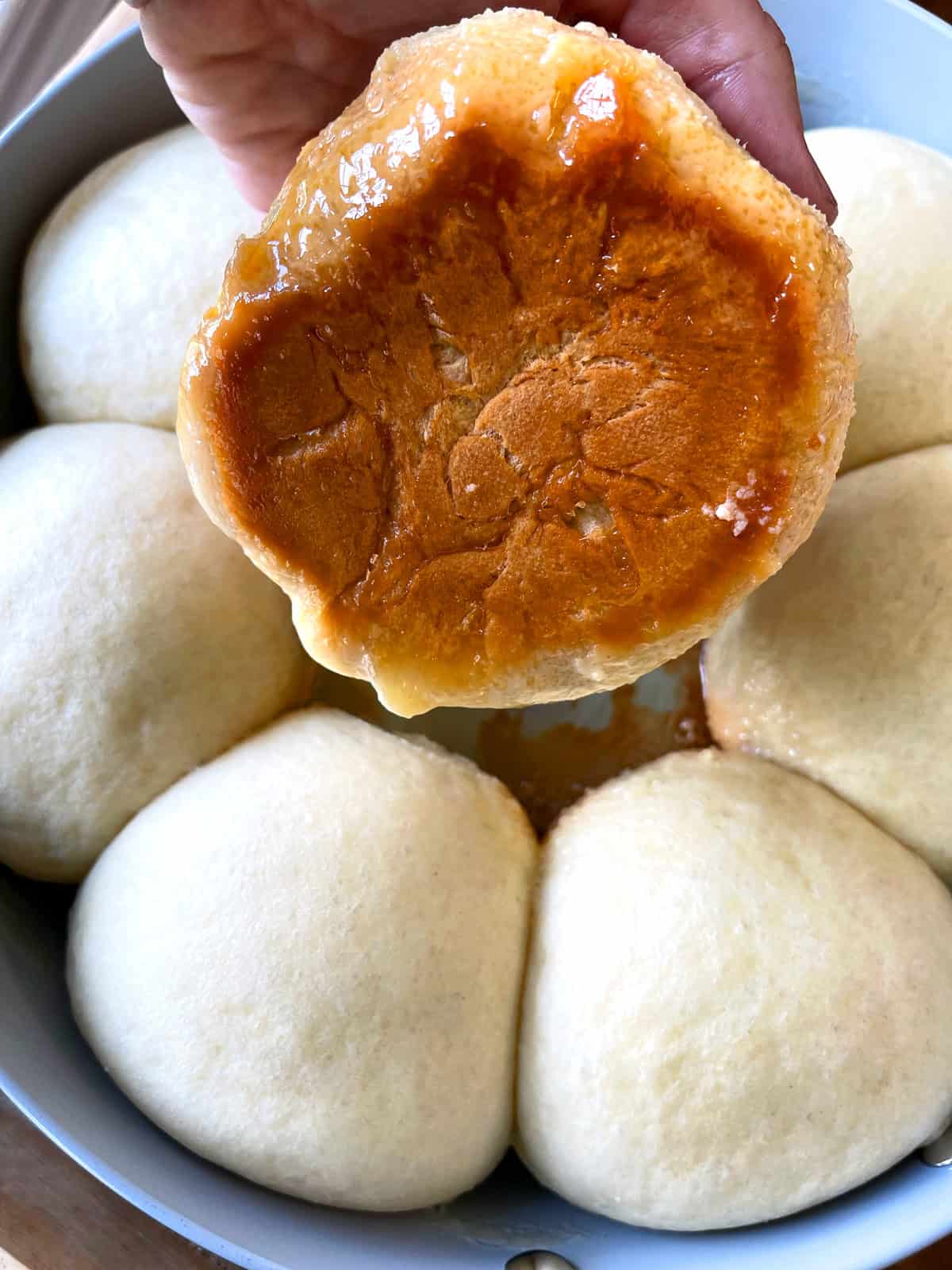
Where Did They Originate?
And with that question we are treading on tumultuous ground. No one disputes that they are of Southern German origin. But which region of Germany is where the debate ensues. Bavaria claims it as their own as does Rheinland-Palatinate. In 2000 the Bavarian Ministry of Agriculture claimed it as a regional speciality in their online database. I’m not sure why it took them 8 years to respond, but in 2008 the minister of the Rheinland-Pfalz Ministry of Agriculture sent a letter of complaint, to which the Bavarian minister offered the reassurance that they would not be seeking regionally protected EU status for the dish. Where I’m from in Baden-Württemberg, nestled in between the two, we just enjoy our Dampfnudeln with a knowing smile while the other two duke it out.
That said there are some regional differences. Rheinland-Pfalz/Palatinate traditionally steams their Dampfnudeln in salt water (and they’re also commonly eaten with savory sides), while Bavarian Dampfnudeln are decidedly a dessert: steamed in milk, butter and sugar and drenched in vanilla sauce. The latter is also the way we make them in Swabia and is how I enjoy them best. And just as in Bavaria, even though it’s a dessert it is served as a main meal because it’s so filling.
An interesting story, there’s a legend surrounding the town of Freckenfeld in Rheinland-Pfalz from the time of the Thirty Years’ War. The Swedish calvary was making huge financial demands of the village, threatening to plunder and murder if the villagers did not comply. The village managed to persuade the Swedish soldiers that if they spared them they would ensure the calvary was well fed. The village master baker, Johannes Muck, went to work making steamed dumplings while his wife and maid cooked up a large pot of sauce, and the soldiers ate until they were full. In total Herr Muck is said to have made 1286 Dampfnudeln. The Swedish calvary accepted the offering and spared the village. In commemoration of the event, the town of Freckenfeld erected the Dampfnudeltor (Dampfnudel gate) made with two arches boasting a total of 1286 stone Dampfnudeln. This gate has been on the town’s official coat of arms since 1938. I have not counted the Dampfnudeln to verify the claim, but I’m happy to give them the benefit of the doubt.

Variations
As noted above, there are regional variations. I have lived in southern, central, and northern Germany and have visited everyone in between, and by far the most popular way of making Dampfnudeln is steamed in milk, butter and sugar and served with vanilla sauce. Some German cooks like to add a drizzling of browned butter, my Mutti being one of them. As already mentioned, the Rheinland-Palatinate region traditionally steams their Dampfnudeln in salt water and there the dumplings are also commonly served as a savory dish. While some cooks throughout Germany like to put a filling in their Dampfnudeln, usually stewed fruit or preserves, Dampfnudeln traditionally are not filled. This is contrast to the Austrian version, known as Germknödel (also popular in Bavaria), which are filled with spiced plum preserves and are served drizzled with browned butter, crushed poppy seeds and powdered sugar (no vanilla sauce). And so in Germany, and likewise in Austria, you’ll sometimes see crossover versions of the two. In the end, make your Dampfnudel whichever way you like.
While not traditional, other flavorings you can add to your Dampfnudel dough for some variation include lemon zest and ground cardamom, a combination that you can find in other traditional German baked goods and is also found, for example, in Danish Aebleskiver.
But in my opinion, which is shared by most Germans, a Dampfnudel simply isn’t a Dampfnudel with vanilla sauce! Grab my recipe for homemade German Vanilla Sauce (Vanillesoße), it’s irresistibly delicious!
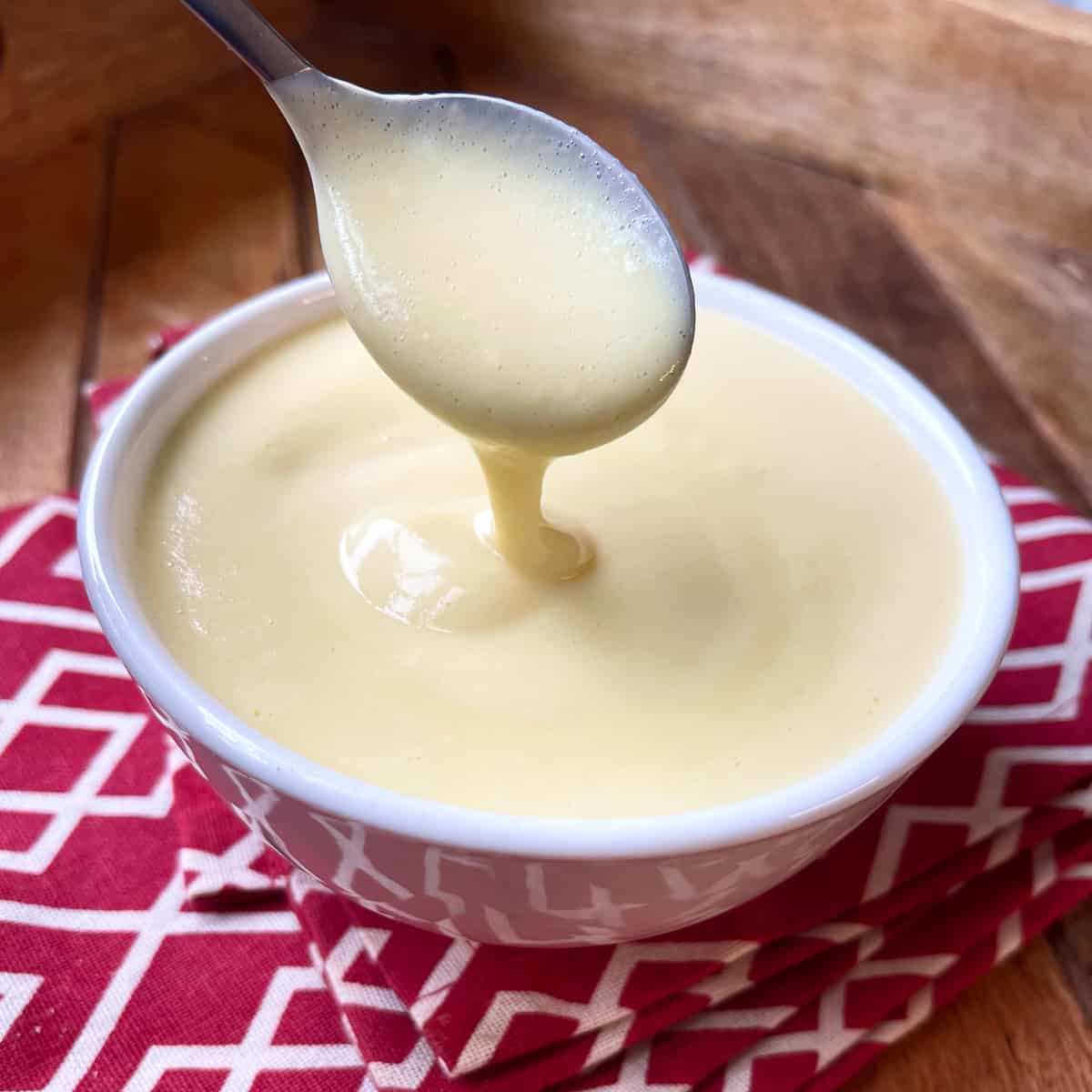
Can You Freeze Dampfnudeln?
Yes you can! If this recipes makes too many for your needs or you want to make extra, they can frozen to conveniently have on hand for another occasion. Simply allow the Dampfnudeln to cool completely then transfer them to a freezer-safe container. They can be frozen for up to 3 months. Then let them thaw in the fridge overnight and reheat in the microwave in a covered container.
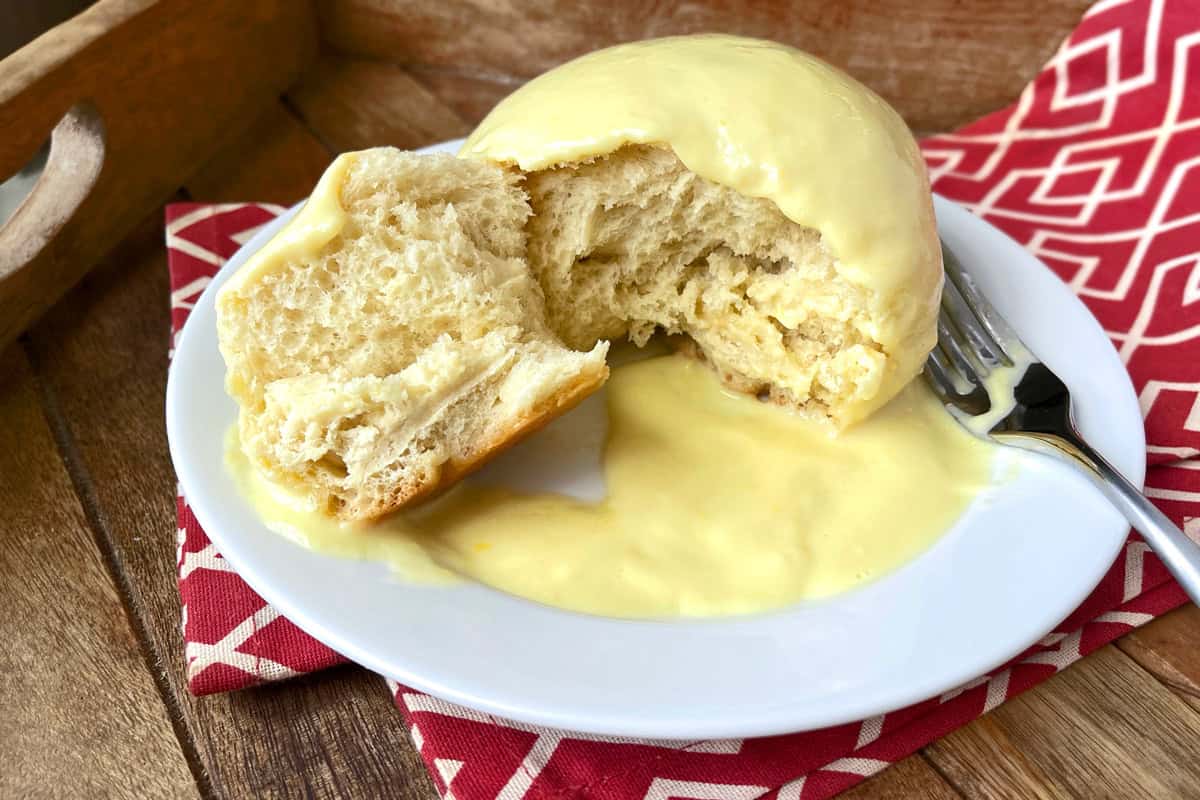
Dampfnudel Recipe
Let’s get started!
Place the flour, sugar, yeast, salt, egg, melted butter and milk in the bowl of a stand mixer. (Contrary to popular thought, active dry yeast nowadays does not need to be dissolved first. You can also use instant yeast if that’s what you have.)
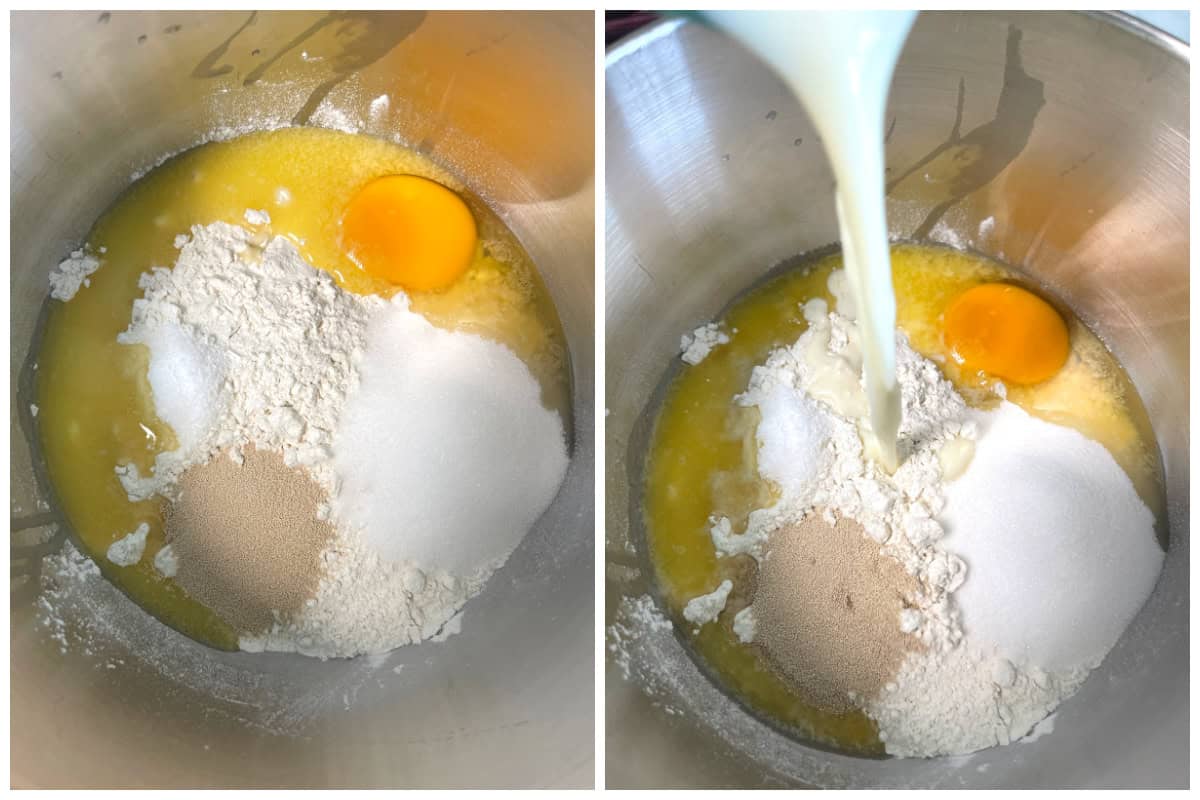
With the dough hook attached, mix the dough until it comes together (add a little more milk if needed) and then continue to knead for about 4 minutes. You should have a soft and pliable dough.
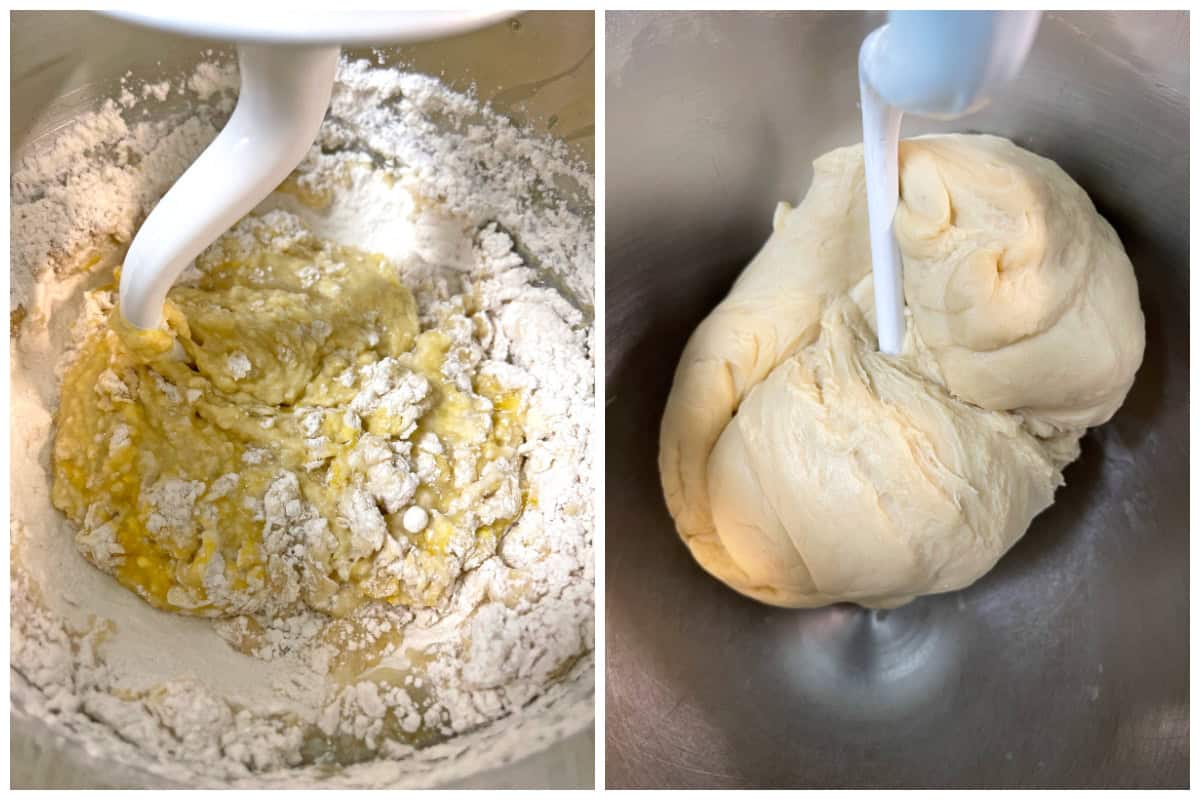
Spray the bowl with some oil, shape the dough into a ball and place it in the bowl. Cover with plastic wrap and set it in a warm place to rise for 60-90 minutes, or until the dough has doubled in size.
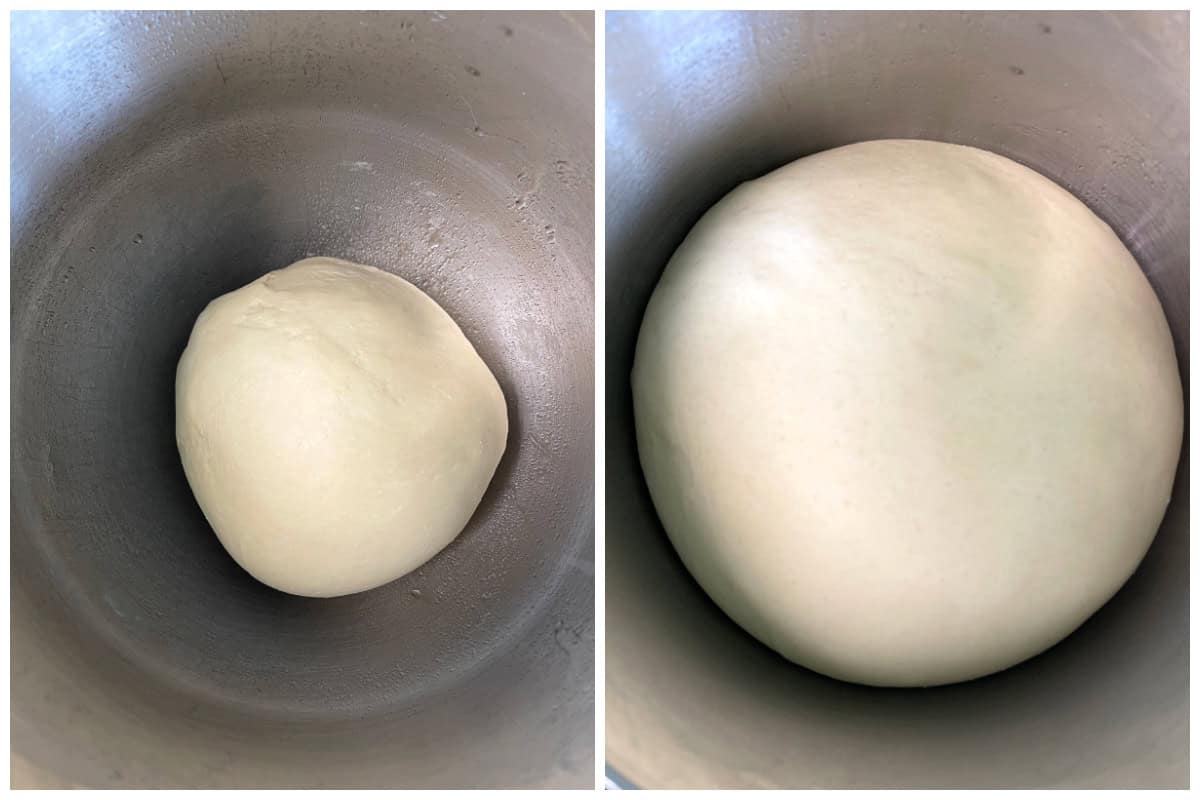
Punch down the dough. Place it on a lightly floured work surface and cut it into 8 roughly equal pieces. I often weigh the pieces, added a little more dough from the larger ones to the smaller ones just because I like them to be as uniform in size as possible (they’ll be approximately 140 grams/5 ounces each).
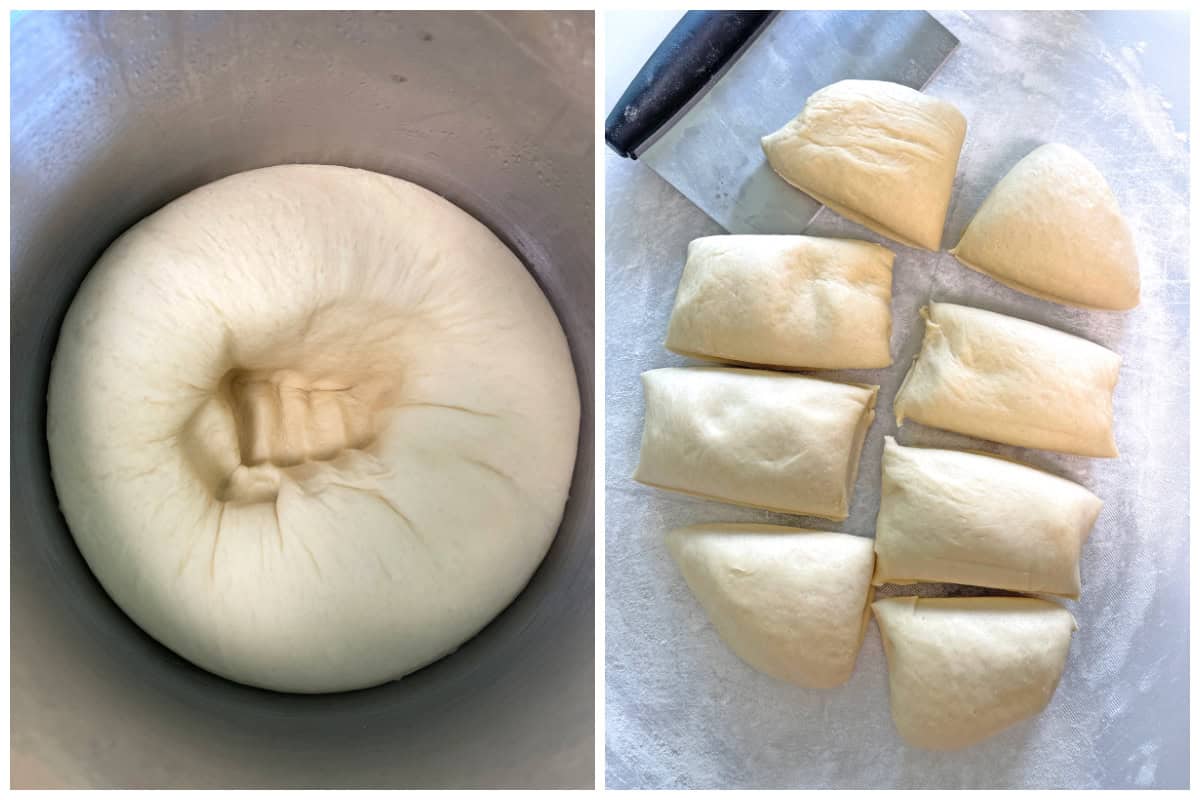
Shape the dough into individual balls, squeezing the seams together at the bottom and then lay the balls on the lightly floured work surface, seam side down, and spread apart to give them room to expand.
Cover with a kitchen towel and let them rise in a warm place for another 30-60 minutes or until puffy.
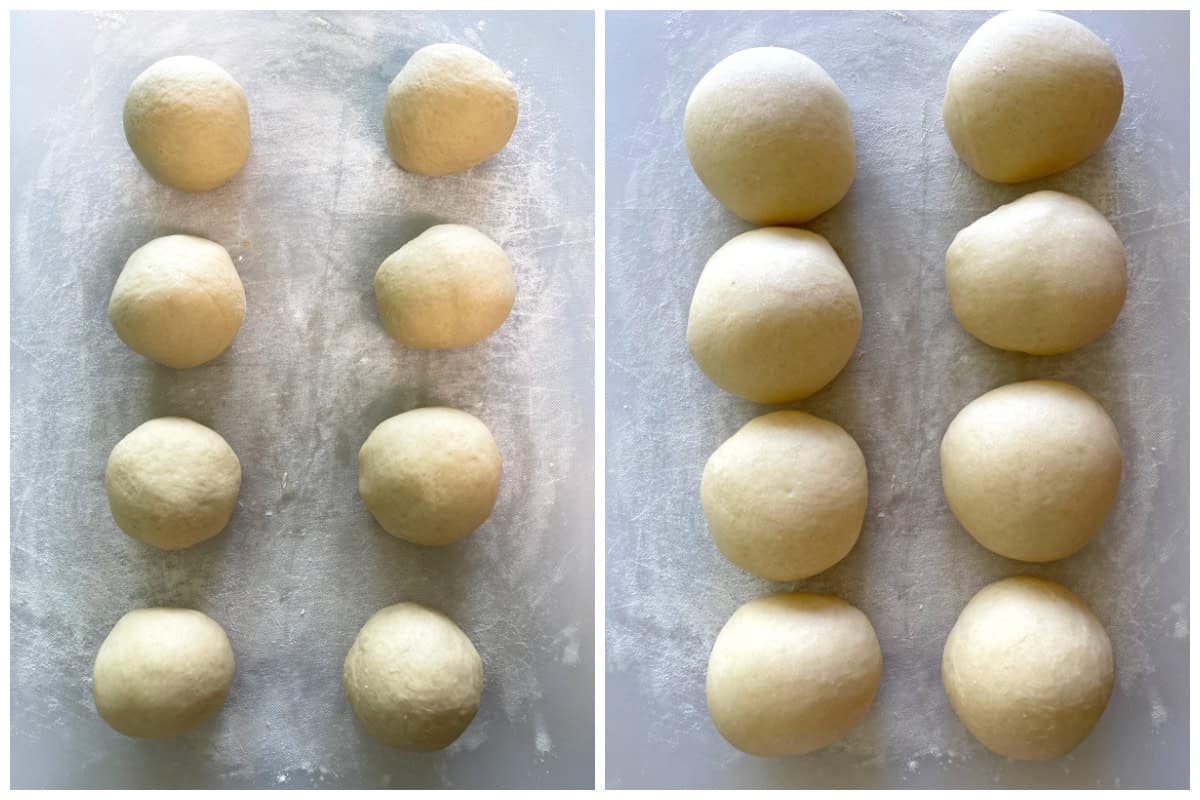
Place the milk, butter and sugar in a large non-stick skillet with high sides. It is imperative that the pan is non-stick otherwise disaster will ensue. I’m using a 5 quart 12-inch ceramic saute pan that fits 8 Dampfnudeln perfectly. Heat the milk to a low simmer, stirring until the butter and sugar is melted.
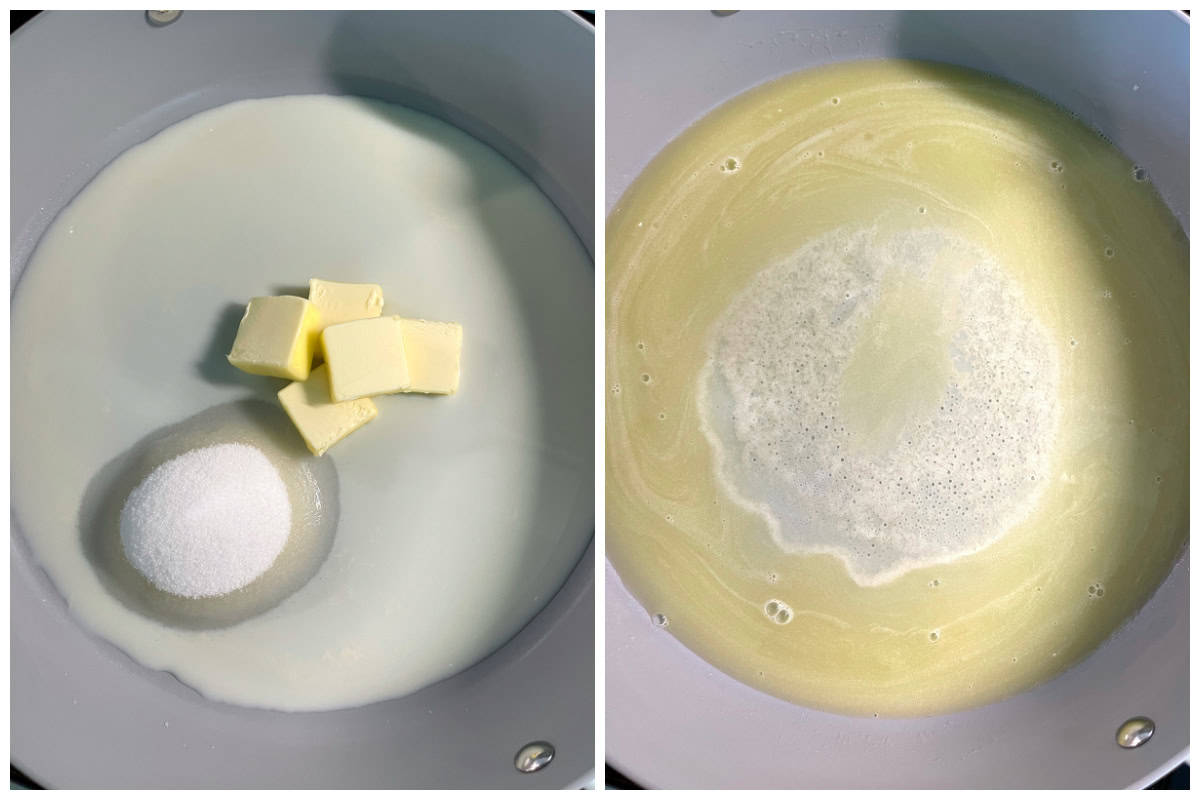
Place the Dampfnudeln in the pan. Don’t smash them together, they need to have some room to expand. Return the milk to a very low simmer. Dampfnudeln are cooked not by boiling but by steaming them. Place the lid on the pan. Let the dumplings cook for about 30 minutes.
WARNING: Whatever you do, do NOT open the lid. The release of the built up steam and introduction to cooler air will cause the dumplings to collapse. I like to use a pan with a glass lid so I can see what’s going on inside.
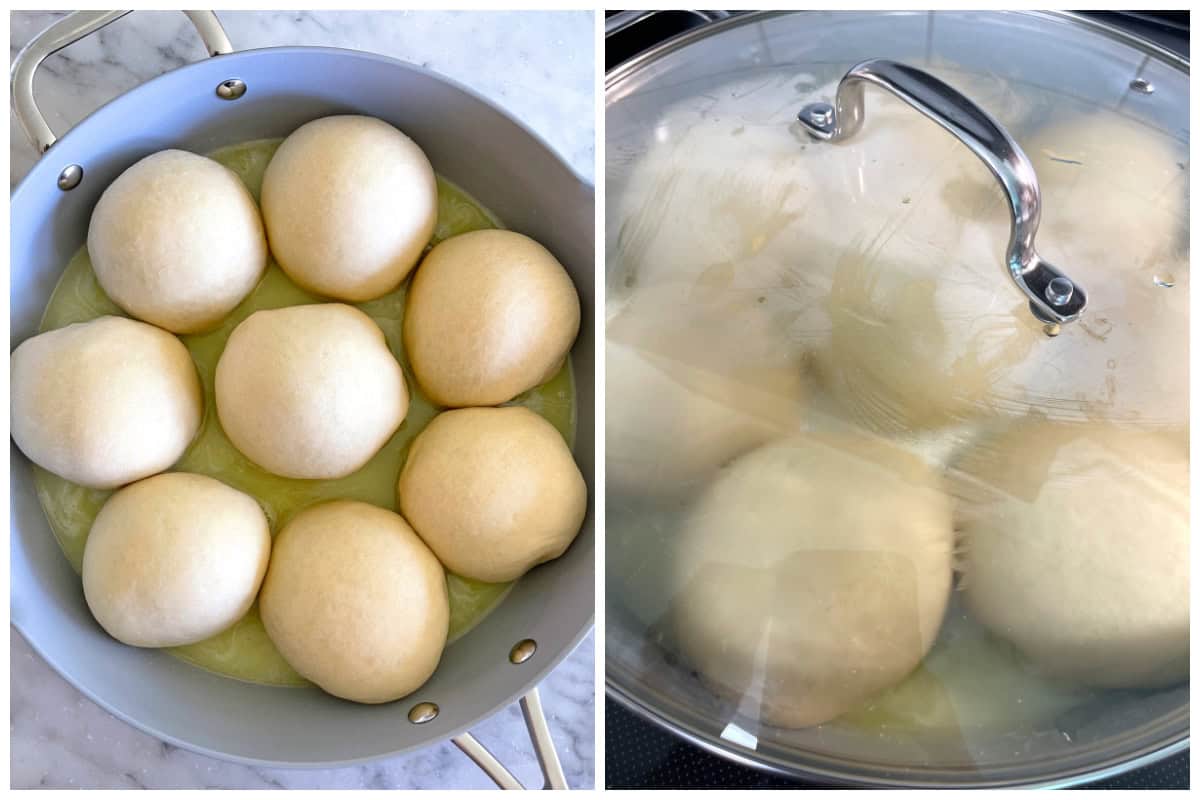
After about 30 minutes the dumplings will have risen beautifully and will be cooked through. Their interiors will be soft and fluffy.
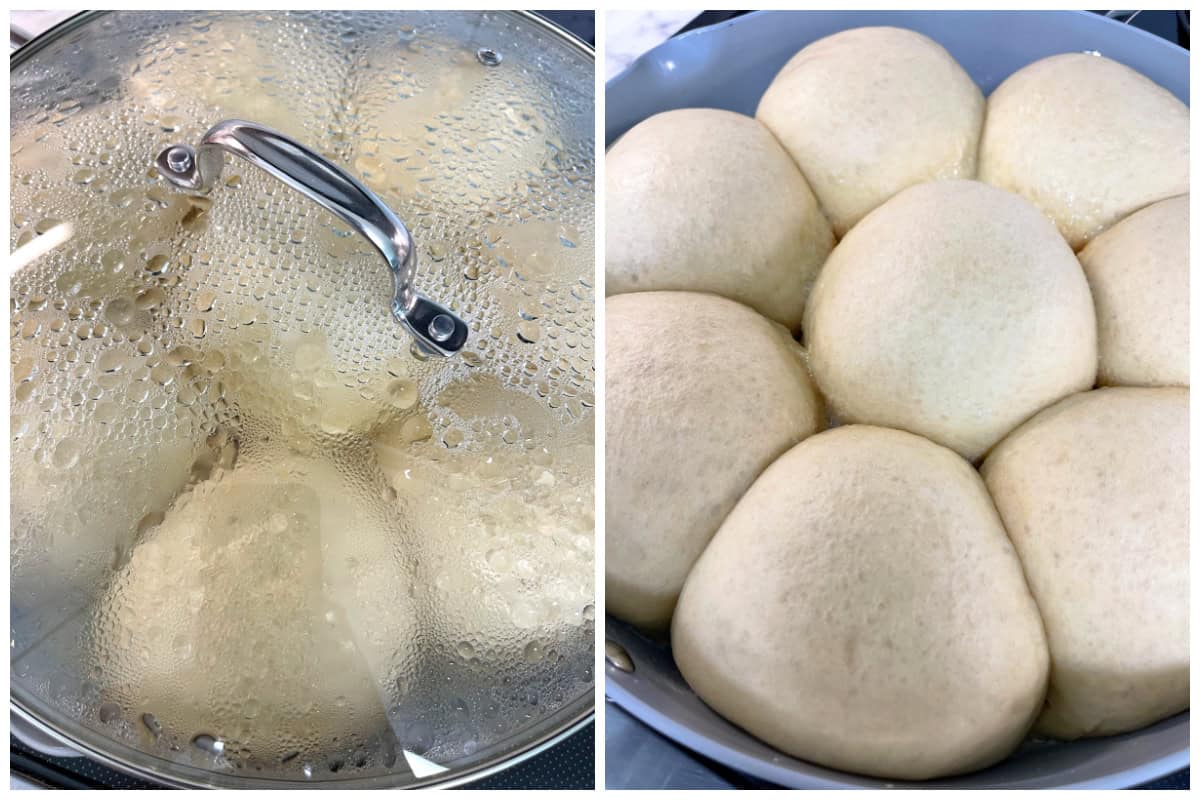
At this point the final step is to remove the lid, increase the heat just a little, and cook for just a few minutes longer allow any remaining liquid to evaporate while simultaneously allowing the bottom of the dumplings to brown. Just be careful not to let them burn!
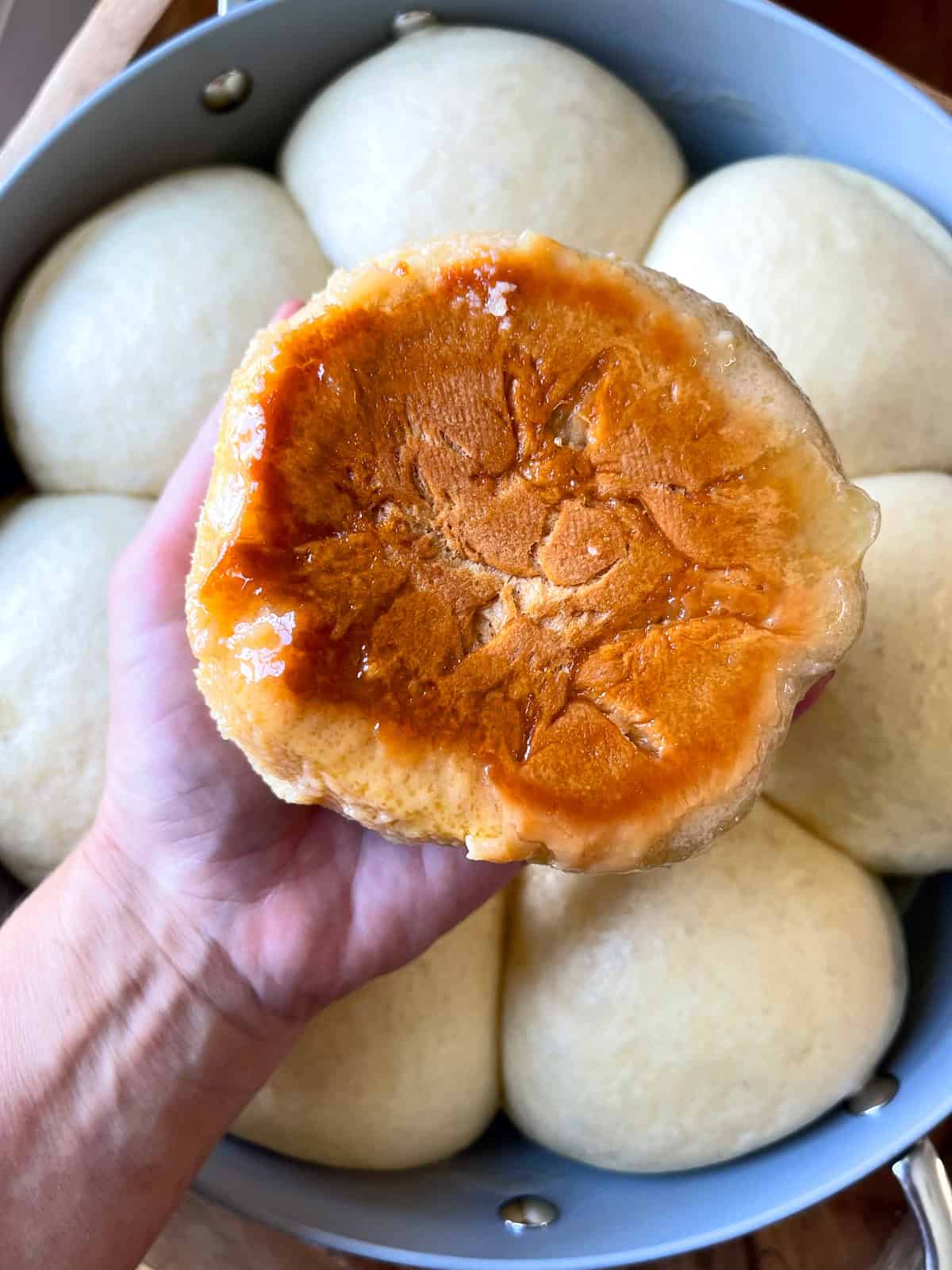
Serve each Dampfnudel with some browned butter and my homemade German Vanilla Sauce.
Guten Appetit!
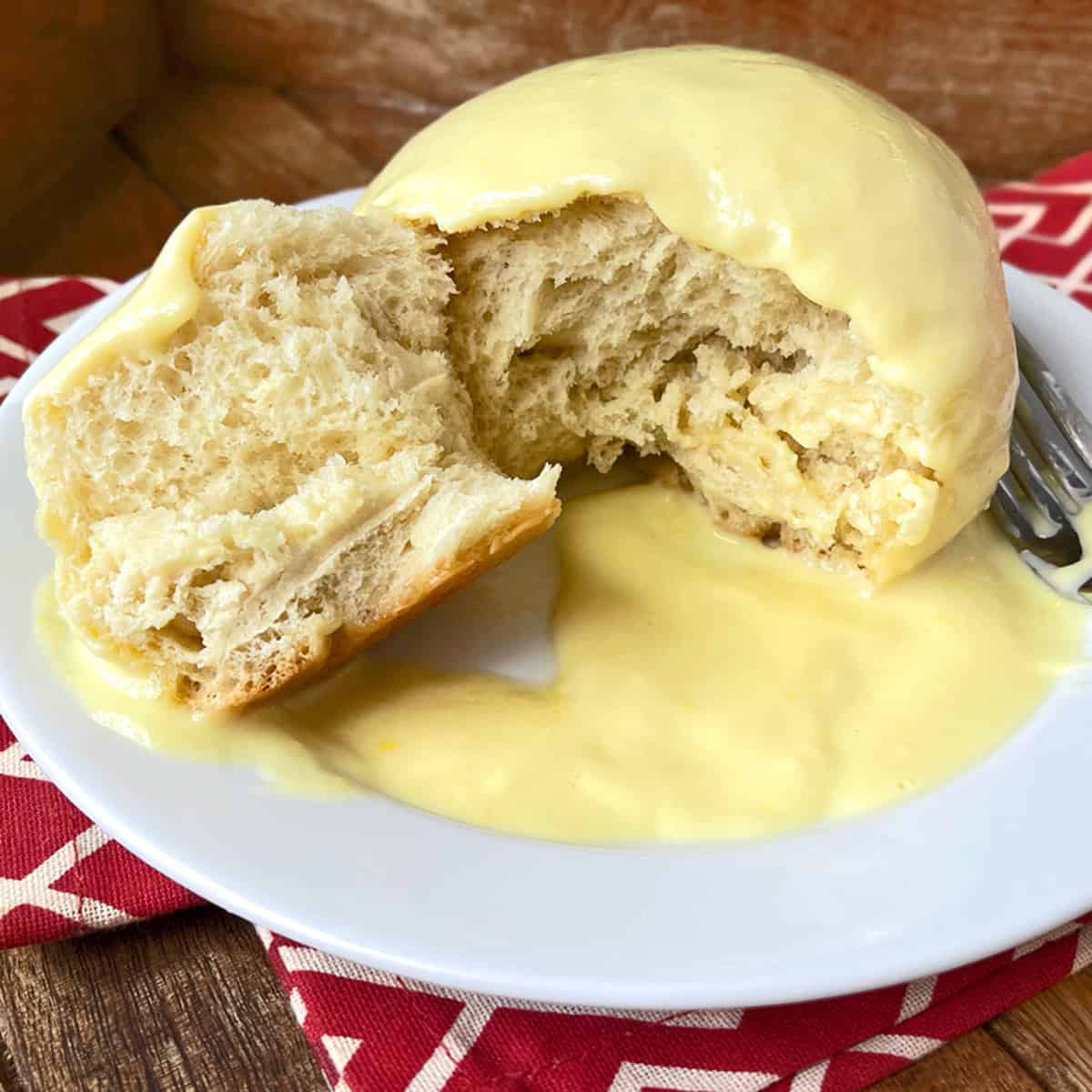
For more traditional German goodies be sure to try our:
- German Apple Cake
- German Plum Cake
- German Cheesecake
- Berliner
- Apple Strudel
- Cherry Marzipan Streusel Cake
- Gugelhupf
- Stollen
- Rhubarb Streusel Cake
- Pfeffernüsse
- Lebkuchen
- Zimtsterne
- Vanillekipferl
- Springerle
Save This Recipe
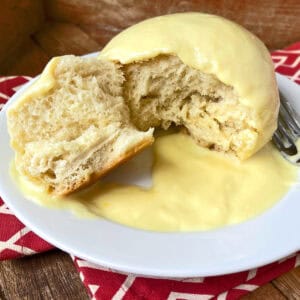
Dampfnudel (German Steamed Dumplings)
Equipment
Ingredients
- For the Dampfnudeln:
- 4 cups all-purpose flour
- 2 teaspoons active dry yeast , or instant yeast
- 1/4 cup sugar
- 1/2 teaspoon salt
- 1 cup milk , at room temperature
- 4 tablespoons unsalted butter , melted
- 1 large egg , room temperature
- For the Pan:
- 1/2 cup milk
- 1/2 cup sugar
- 4 tablespoons unsalted butter
- German vanilla sauce , for serving (click link for recipe)
- browned butter , optional (drizzle over the dumplings followed by the vanilla sauce)
Instructions
- Place the flour, sugar, yeast, salt, egg, melted butter and milk in the bowl of a stand mixer. (Active dry yeast nowadays does not need to be dissolved first.) With the dough hook attached, mix the dough until it comes together (add a little more milk if needed) and then continue to knead for about 4 minutes. You should have a soft and pliable dough.Spray the bowl with some oil, shape the dough into a ball and place it in the bowl. Cover with plastic wrap and set it in a warm place to rise for 60-90 minutes, or until the dough has doubled in size.
- Punch down the dough. Place it on a lightly floured work surface and cut it into 8 roughly equal pieces. I often weigh the pieces, added a little more dough from the larger ones to the smaller ones just because I like them to be as uniform in size as possible (they'll be approximately 140grams/5 ounces each).Shape the dough into individual balls, squeezing the seams together at the bottom and then lay the balls on the lightly floured work surface, seam side down, and spread apart to give them room to expand.Cover with a kitchen towel and let them rise in a warm place for another 30-60 minutes or until puffy.
- Place the milk, butter and sugar in a large non-stick pan with high sides (non-stick is a must). I use a 5 quart 12-inch ceramic saute pan that fits 8 Dampfnudeln perfectly. Heat the milk to a low simmer, stirring until the butter and sugar is melted.Place the Dampfnudeln in the pan. Don't smash them together, they need to have some room to expand. Return the milk to a very low simmer. Dampfnudeln are cooked not by boiling but by steaming them.Place the lid on the pan. Let the dumplings cook for about 30 minutes.Whatever you do, do NOT open the lid while the dumplings are cooking. The release of the built up steam and introduction to cooler air will cause the dumplings to collapse. I like to use a pan with a glass lid so I can see what's going on inside.After about 30 minutes the dumplings will have risen beautifully and will be cooked through. Their interiors will be soft and fluffy.At this point the final step is to remove the lid, increase the heat just a little, and cook for just a few minutes longer allow any remaining liquid to evaporate while simultaneously allowing the bottom of the dumplings to brown. Just be careful not to let them burn.Serve the Dampfnudeln drizzled with some browned butter (optional) and homemade German vanilla sauce.



















That was my favorite as a kid. My (Bavarian) mom would also drizzle raspberry’s and raspberry syurp on top. Yum! Too bad its not Keto friendly lol. This is top on my list followed by Bienenstich :)
Definitely delicious with the raspberries. My Oma would always very generously fill the center of Dampfnudel with fruit preserves/jam. And I wouldn’t be one to object to some extra one top :) Oh I’m with you all the way on the keto thing. If only there were good keto versions of both Dampfnudeln and Bienenstich! *long sigh*
I remember having these as a child with the vanilla sauce. But I remember my mother baking them because they were browned on top???? can you bake this recipe rather than boil?
Hi Joanne, those were Rohrnudeln or Buchteln – same thing, just different names by region, and they’re baked instead of steamed!
Absolutely delicious! I made your vanilla sauce to go with it and there smiles and praises from all around the table.
Yay, I’m so glad they were a hit! Thank you so much, Cori!
This was so very special. The memories it brought back for me. I’m a German expat and have been living in Wisconsin for over 30 years. This tasted like home.
I’m so happy to hear that, Marion, thank you! <3
I would love to try these, however I don’t have a non-stick pan. Surely this recipe preceded the invention of non-stick cookware?
Hi Pamela, I completely understand the conundrum. I avoid non-stick cookware like the plague and ONLY have one strictly for the purpose of making Dampfnudeln. Seriously. I have tried making these in cast iron pans and Dutch ovens, including enamel-coated ones, and they inevitably end up sticking to the bottom. If you have a well-seasoned tall cast iron pan with a lid I would say give it a go. If it sticks to the bottom and you have to rip it free, it will still taste good even if it’s not picture perfect :)
I grew up in Heidelberg and my mother would make Dampfnudel on Saturdays with Kartoffelsuppe zum mittagessen around noon. They had a salty crust and I still make them that way, also with the soup.
Traditions are important and that’s wonderful that you’ve kept that up. Thank you for sharing, Petra.
THANK YOU for posting this recipe for Dampfnudeln!!! Not wanting to generate any discord, but would you consider possibly expanding your recipe to also include cooking the Rheinland-Pfalz version (from the Heidelberg area myself, and this is what we’re used to)? We used to enjoy these with soup.
The actual dough, I suspect, would be the same. However, I vaguely remember my Mutti putting oil into the pan (cast iron), sprinkling over the oil, salt and then placing the balls of dough into the pan. Just before closing the lid, she would cautiously pour a bit of water into the pan and quickly shut the lid (obviously being very careful due to the explosive nature of mixing oil and water). And then they would steam. Is this right? The result would be a salty crust on the bottom. Although, dissolving the salt into the water might be a better option as the salt would be better distributed throughout (???).
I’ve never been successful recreating them but I like the recipe you’ve provided and am highly motivated to give it a go, but as a savory dish. Can you provide any specifics for salt-water version, please?
Again, thank you (REALLY LOVE all the history and background you provide in your posts!!!). I need to go make lunch now as I have this sudden urge for Linsesuppe mit Weiner.
You’re welcome, Ron, and thank you for your kind words. I’m so glad you appreciate the history and background, I’m always fascinated by food history :) To make Pfälzer Dampfnudeln it’s exactly the same – same exact dough, same steaming method – the only difference is that instead of steaming the dumplings in milk/butter/sugar, you steam them in salted water with a tablespoon or so of oil any neutral-flavored oil. Same process at the end too where you lift off the lid to let the water evaporate to allow the bottoms of the dumplings to brown a bit. As mentioned, the recipe for the dough is identical, including the sugar, even when they’re served as a savory dish (it’s not enough sugar to actually make them “sweet”). Happy steaming! :)
As a little girl, I used to spend nights at an Aunt’s house (who lived in Bad Reichenhall, Bavaria). She was famous for her “Dampfnudeln”. Oh, how I looked forward to them. I have been longing to make them, just waiting to see the right recipe. I believe this is it. Funny thing, my Uncle would eat these with sauerkraut instead of vanilla sauce. Weird, but he loved it. I’m looking forward to trying this recipe.
Yes, in some areas of Germany they eat Dampfnudeln as a savory dish as well as a sweet one. Where I’m from they’re only eaten as a dessert but I can imagine they’re really good with Sauerkraut and Speck and lots of good German gravy :) Please let us know what you think when you’ve had a chance to try these! And definitely make the homemade vanilla sauce with them :)
I love anything with yeast, be it bread or cakes, so when I saw this I knew I had to make it. I love German food (have made many of your recipes and love them all) but I’ve never had these though I think I’ve heard of them at some point. I agree with the other comments, they were heaven on a plate. Now on to make your Germknoedel!
Hi Leticia, I’m with you all the way on loving yeasted breads and cakes <3 I'm thrilled that you enjoyed these, thank you!
KIMBERLY, I’ve died and gone to heaven! I’ve been waiting for this one for ages and my patience has finally paid off. These were everything I was hoping they would be. And YES, I did double the vanilla sauce and I’m glad I did because everyone around the table was reaching for more. High praises for these Dampfnudeln from the family.
Oh that makes me so happy, Clarissa! :) I’m so glad that you and your family enjoyed these and I really appreciate the feedback, thank you!
Oh these were soooo delicious! I love all things yeast which is why I’m partial to German baked goods (and because it’s my home, lol). These Dampfnudeln were simply amazing. Such a nice fluffy texture and flavor and that vanilla sauce, oh my. It’s lucky any of it even made it to the table, I would have gladly eaten it all with a spoon, lol! Thank you for another great recipe, Kimberly!
I’m so thrilled that you enjoyed them, Katrin, they’ve always been a favorite of mine. :) Thank you so much for the feedback!
These were exquisite! So fluffy and wonderful and the homemade vanilla sauce was to die for. These are even better than what I had in Germany, and I’m from Germany!
I’m so happy you enjoyed them, Marianne, thank you very much!
Oh my, those look and sound like absolute heaven! I’ve heard of these but never had the opportunity to try them when I was in Germany. I’m definitely going to try them soon along with your vanilla sauce. Thank you, Kimberly, I’m excited!!